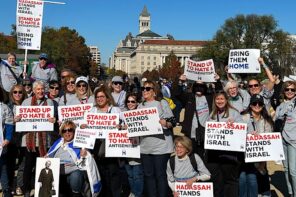Like others who study American Catholicism, I’ve spent time recently with the Pennsylvania grand jury report naming credible allegations of sexual abuse of minors by Catholic clergy. The heavily publicized, 900-page document is a civic tour de force; it names 301 Catholic priests who, during the twentieth century, were employed across 6 dioceses in Pennsylvania. It records their alleged crimes—and those of bishops who protected them—in excruciating detail.
From the vantage point of Albuquerque, New Mexico, where I live and teach, the grand jury report provides not only a horrific portrait of some parts of Catholic life in a mid-Atlantic state; it offers reminders too of the devastating and often overlooked history of clerical sexual abuse here in the U.S. Southwest. New Mexico was arguably the epicenter of 20th century priestly sexual violence; several of the clergy named in the grand jury report made their way eventually from Pennsylvania to New Mexico. They came because, for much of the century, bishops from across the nation disposed of their worst offenders by sending them for “treatment” here. The priests came to the Via Coeli Monastery, run by the Servants of the Paracletes in the mountains near Jemez Springs. The monastery opened in 1947, and over the years more and more of its residents were men who, according to the congregation’s founder, were “addicted to abnormal practices” including “sins with the young.”
Many of the priests who moved to Via Coeli were eventually released into work with children and adults in New Mexico. The career of Fr. Edward Graff, detailed in the Pennsylvania grand jury report, exemplifies this pattern. Graff was a priest in the Diocese of Allentown for nearly thirty years. During his time there, the grand jury tells us, he “raped scores of children.” Eventually, in the late 1980s, Graff was removed to the Paracletes for treatment. Upon his release, Bishop Thomas Welsh of Allentown “authorized [the priest] to begin ministry to the needy in the Archdiocese of Santa Fe, New Mexico” under the continued supervision of the congregation. Archbishop Robert Sanchez of Santa Fe agreed, and granted Graff “limited faculties” to carry out work with the homeless and with AIDS patients in Albuquerque.
Edward Graff’s journey to Jemez Springs and then on to Albuquerque is typical of the movements of Catholic pedophile priests in New Mexico. From the mid-1960s it was policy within the Archdiocese of Santa Fe to permit clergy under the Paracletes’ supervision to perform active ministry in communities across the state. In the words of Sanchez’s predecessor Archbishop James Davis, this transition into the local community was considered “a final step in the graduated program of rehabilitation.”
Over the next decade of his life, Graff lived in Albuquerque and also in the Diocese of Amarillo, whose bishop reported him working among “people who are almost totally Hispanic and among the poorest of the poor.” His abusive behavior apparently didn’t change. While in Texas in 2002, Graff was arrested for sexually abusing a fifteen-year-old boy he had employed in his rectory. Following his arrest, one investigator on the case was quoted as saying, “Graff would hire mostly Hispanic boys in their early teens to clean the rectory and mow the lawn.” The priest died in a Texas prison while awaiting trial.
I want to highlight Graff’s time spent in New Mexico, as well as his work among Hispanic youth in West Texas, and the tragedy resulting from it, as evidence that race and colonialism are—at this juncture and at every juncture—essential to thinking about clerical sexual abuse in the United States. While the East Coast geography and white-ethnic demographic explored in the recent grand jury report are plenty revealing, the continual emphasis on this geography and demographic in recent coverage of Catholic clerical sexual abuse in the United States not only overlooks the severity of the crisis in other places and among other populations, but it also—importantly—obscures the ways race and colonialism have structured the crisis in communities that are not the white-ethnic Catholic enclaves of the East Coast.
Unfortunately New Mexico is a case in point. In the Archdiocese of Santa Fe alone, at least 82 clergy and religious have been formally accused of sexual abuse. 74 of these names were released by the archdiocese itself last year, and another 8 names not appearing on the archdiocesan list are cataloged on the website BishopAcccountability.Org. One lawsuit filed in Albuquerque claims the archdiocesan list should include perhaps dozens of additional names.
But even a roster of “just” 82 accused priests means that the archdiocese has been home to 1 alleged abuser for every four-thousand or so present-day Catholics living here. One might compare that to the 6 dioceses named in the grand jury report, where a total of nearly 2 million Catholics today reside. Across those Pennsylvania dioceses, there has been roughly 1 accused priest for every six-thousand Catholics currently living there. Even with these rough estimates, it’s safe to say that during the twentieth century, New Mexicans were exposed to abusive priests at a rate much higher—50% higher, or more—than Catholics in the dioceses named in the latest grand jury report.
How do we begin to talk about the astronomical rate of Catholic sexual abuse in New Mexico? The first thing to recognize is this: While clerical abuse in New Mexico has its own sordid history in Via Coelis and its associates, high rates of abuse span Catholic colonial geographies in the United States and elsewhere. Consider, for example, the dioceses of Rapid City and Sioux Falls, which together extend their ecclesial jurisdiction over 6 federal Indian reservations in South Dakota. By 2010, more than 65 Catholic priests and religious formerly employed at Indian boarding schools within those dioceses had been named in lawsuits targeting sexual abuse—a number that suggests a far higher per-capita rate of offending clergy than even in New Mexico.
In New Mexico, the victims of abuse were mainly Nuevomexicano and Indigenous kids. The abusers were often, but not always, white. Many came to New Mexico from faraway places, but some were local men. Colonialism is a structure that has touched everybody and everything here. It has formed New Mexican Catholicism since the arrival of Spaniards in the 16th century, and colonialism came to form Catholicism—and Catholic sex, and Catholic sexual violence—anew with the arrival of Americans in 1848.
For a century and a half after the U.S. annexed New Mexico, layer upon layer of Catholic life developed with and from the ongoing processes of U.S. colonization. Some of these developments in turn laid the groundwork for clerical sexual violence. Over time, for example, Catholic life here was marked by the importation of Anglo priests and religious from the East, and by their roles in the racialization and, at times, sexualization of native-born men, women, and children. Into the twentieth century, it was marked by a failure of the archdiocese to curb the near-feudal styles of governance wielded by priests in some rural parishes, and to respect local lay forms of Catholic authority.
At midcentury it was marked by the Paracletes’ purchase of two thousand acres of “free and available” land in a “safely remote” location for housing pedophile priests—a location that was and is just miles from what is now federally recognized as Jemez Pueblo. And still today Catholic (as well as non-Catholic) life here is marked by extraordinarily high rates of homelessness and drug addiction—the sorts of problems that attracted Edward Graff to his “ministry.” Each of these pieces of Catholic life in the region carries colonialism’s mark, and each came to comprise the vernacular context for clerical sexual abuse in New Mexico.
I don’t write to minimize the historical and contemporary gravity of sexual abuse across Pennsylvania, in Boston, or anywhere else. Others have written thoughtfully about the different, local contexts that shaped those better-known crises. There are many good approaches to grappling with the history of sexually violent priests; the problem is enormous and there’s room for it all. But in New Mexico, in South Dakota, and across lands claimed and colonized by the United States, the one-two punch of race and colonialism has created a crisis within a crisis, and it demands attention from anyone invested in grappling with clerical sexual abuse in the U.S. Catholic Church.




